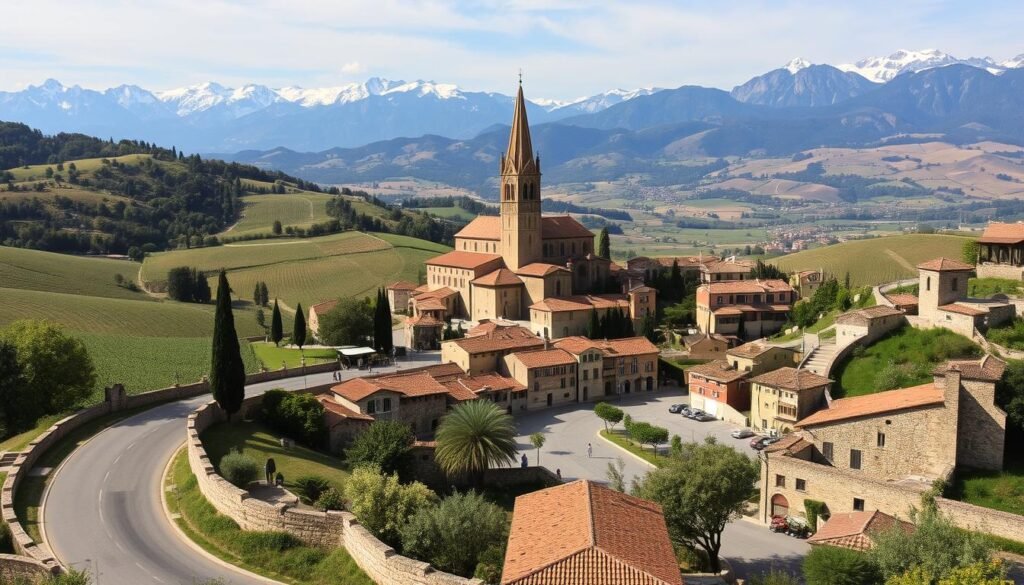Did you know that millions still name this country as the top spot for art, food, and dramatic coastlines? That scale explains why planning feels both exciting and overwhelming.
I set out to gather my favorite destinations into one easy list so you can plan travel that mixes iconic cities and quiet gems. I write from time on the ground, calling out what feels worth a full day and what deserves a slow afternoon.
From Rome’s Colosseum to the Cinque Terre cliffs, Lake Como villas, and the Dolomites’ peaks, I highlight museums, viewpoints, and simple routing ideas I’ve tried and loved. I also note when a car helps and when trains or boats make exploring a breeze.
Key Takeaways
- A single list balances bucket-list icons with quieter stops.
- Mix cities and landscapes for a fuller sense of the country.
- I share practical routing and timing tips for each highlight.
- Book ahead for blockbuster museums; slow down for golden-hour walks.
- Options span north to south so you can match flights and seasons.
Why I Keep Returning: How I Picked the Best Places to Visit in Italy
I pick destinations that keep drawing me back, not for an image but for layered moments that stay with you. I choose spots praised across sources for deep history, living culture, and easy access by train, boat, or short drives.
My list blends headline cities like Rome and Florence with lively food towns such as Bologna and Palermo. I value sites with standout art and architecture — think Uffizi, David, and the Doge’s Palace — and streetscapes that reward slow wandering.
I weigh practical details: can a single base reach several highlights? Is the area walkable once you arrive? Do local people keep traditions that shape meals, markets, and daily rhythms?
- Memorable moments: sunrise walks and piazza people-watching.
- Access matters: trains, ferries, and short drives make smart routing simple.
- Breadth and depth: this list aims to show Italy’s art, empires, and modern life in a way that makes the whole world feel closer.
Rome: Timeless Landmarks, ancient streets, and the heart of Italian history
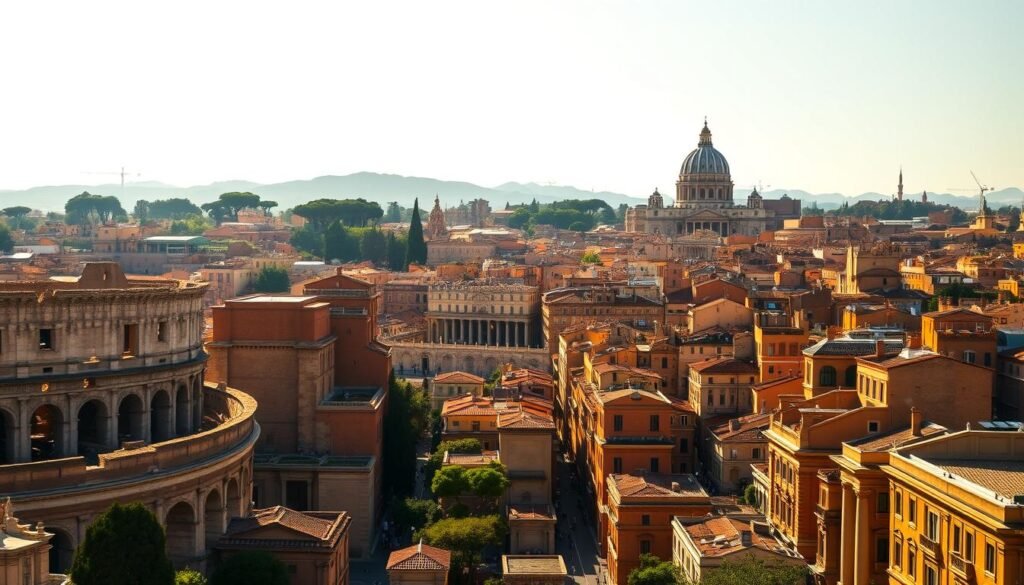
Rome folds deep time into narrow lanes, where emperors’ ruins sit beside lively cafés. I plan walks that group big sights so I waste less energy and enjoy more gelato.
Colosseum to Vatican City: world-class highlights in a day or two
Start with the Colosseum, Forum, and Palatine for a compact morning of ancient life. Then cross toward the Pantheon, Trevi Fountain, and the Spanish Steps for an iconic loop that fits one busy day.
I always book timed tickets for the Vatican Museums and St. Peter’s. That move frees an afternoon for Bernini and Caravaggio pieces without long tourist lines. For quieter history, I cycle the Appian Way or wander the Baths of Caracalla.You can learn about best-island-to-visit-in-hawaii
Where I wander at golden hour: Trastevere and the Tiber bridges
As dusk falls I head to Trastevere. The cobbled streets and bridges over the Tiber glow at sunset and feel more local after dark. I like an evening in the Jewish Ghetto for lively dining and lit piazzas.
“Map clusters of sights so you can walk between them, saving energy and leaving room for spontaneous side streets.”
| Highlight | Why I go | When |
|---|---|---|
| Colosseum / Forum | Ancient ruins that anchor the city | Morning |
| Vatican / Sistine | World-class art and sacred spaces | Afternoon (timed entry) |
| Trastevere | Golden-hour walks and local nights | Evening |
Florence: Renaissance art, Santa Maria del Fiore, and romantic river views
https://www.youtube.com/watch?v=fZlRB4EHbII
Florence compacts a century of creative energy into a walkable city that rewards slow looking.
I start museum days by booking Uffizi and Accademia tickets ahead so I can linger over paintings rather than rush through galleries. Michelangelo’s David and the Uffizi’s collection anchor my itinerary.You can learn about best-national-parks-to-visit-in-the-us
Uffizi, David, and Duomo climbs: art and architecture I never skip
I choose one climb per visit—either Brunelleschi’s Dome or Giotto’s Bell Tower—for sweeping views of terracotta roofs and the Arno. One ascent gives me the panorama without wearing out my feet.
- I split art days with architecture, letting Santa Maria del Fiore’s exterior and interior frame the masterpieces.
- I time a slow walk across Ponte Vecchio before sunset, then head toward Piazzale Michelangelo for evening light.
- I slip into smaller churches for quiet frescoes and sculpture; these moments balance the larger highlights.
- Two days cover the big museums, a tower climb, and a relaxed riverside loop with time for good meals.
“Build your day around key anchors and leave room for unplanned discoveries.”
| Highlight | Why I go | Timing | Tip |
|---|---|---|---|
| Uffizi Gallery | World-class paintings and Renaissance masters | Morning (timed entry) | Book ahead |
| Accademia | Michelangelo’s David | Late morning | Combine with nearby sites |
| Duomo / Dome or Bell Tower | Iconic architecture and city views | Afternoon | One climb per visit |
| Ponte Vecchio & Piazzale | River views and sunset panoramas | Evening | Walk slowly and photograph |
Venice: Gothic palazzi, quiet backstreets, and lagoon magic beyond the crowds
![]()
I find Venice most addictive when its monuments give way to winding lanes and lagoon light. The city’s center spins around St. Mark’s Square, where St. Mark’s Basilica and the Doge’s Palace anchor the morning.You can learn about best-places-to-visit-in-europe
I start early at the basilica for its mosaics, then cross to Doge’s Palace before the tourist wave builds. A short ride up St. Mark’s Campanile delivers textbook views over domes, rooftops, and the sea-lagoon horizon.
By late morning I let the backstreets lead me. Getting pleasantly lost reveals artisan shops and quiet campo squares. The waterfront promenades along the Riva glow at sunset and make a simple lagoon-facing walk feel cinematic.
How I structure a calm day
- I pair one marquee sight with long, meandering hours in lesser-visited sestieri.
- I keep dinner plans flexible—many memorable meals came from following local chatter down a narrow street.
- For hidden corners and extra ideas, I also recommend this guide on hidden gems in Venice.
“The city exhales when you trade the square for a quiet canal.”
Cinque Terre: colorful houses, cliffside trails, and a UNESCO World Heritage coastline
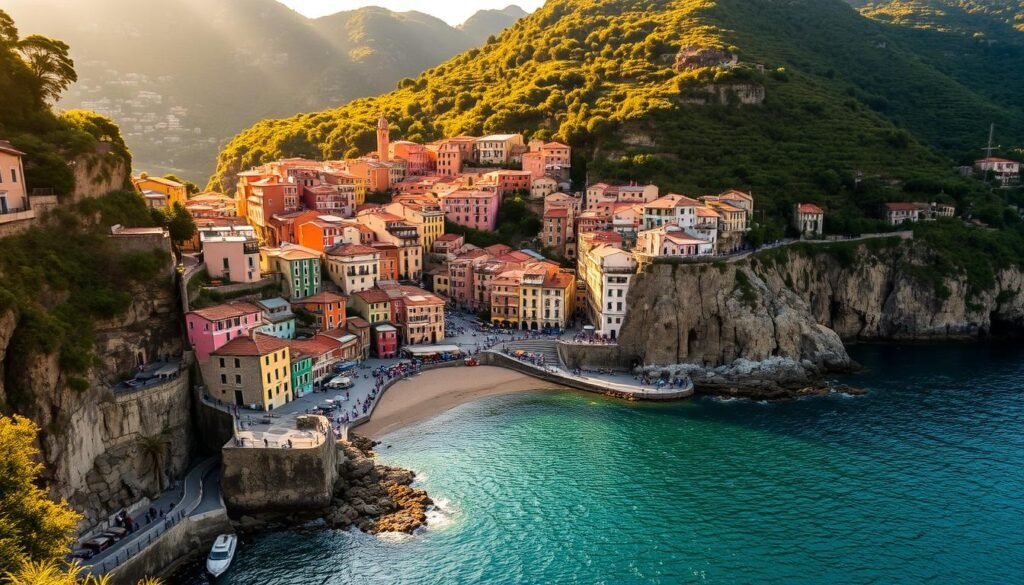
On the Ligurian shore, five tiny villages cling to cliffs and reward slow walks with sweeping sea views. I use the local train to hop from town to town, then hike short trail stretches for those classic panoramas.
Monterosso, Vernazza, Manarola, Corniglia, Riomaggiore: how I link the villages
Monterosso is my beach-and-gelato stop. Vernazza and Manarola are where I linger for harbor photos and colorful houses that glow at golden hour.You can learn about best-time-to-visit-greece
I climb toward Corniglia for a quieter perch and wide views. The local train saves time on steep stairs, so I pack light and move easily between stations.
Food I crave here: pesto, fresh seafood, and crisp Ligurian whites
I plan one relaxed day around food: trofie al pesto, anchovies, and a chilled Ligurian white in a tiny trattoria. Two days let me savor the coastline without rushing, though even one well-planned day delivers big scenery.
“Pack light, follow the trails, and let a slow meal anchor your afternoon.”
- Tip: Use the train for quick hops, hike favorite viewpoints on foot.
- Timing: Aim for early starts to beat crowds and catch soft light.
Lake Como: grand villas, storybook towns, and alpine-meets-lake beauty
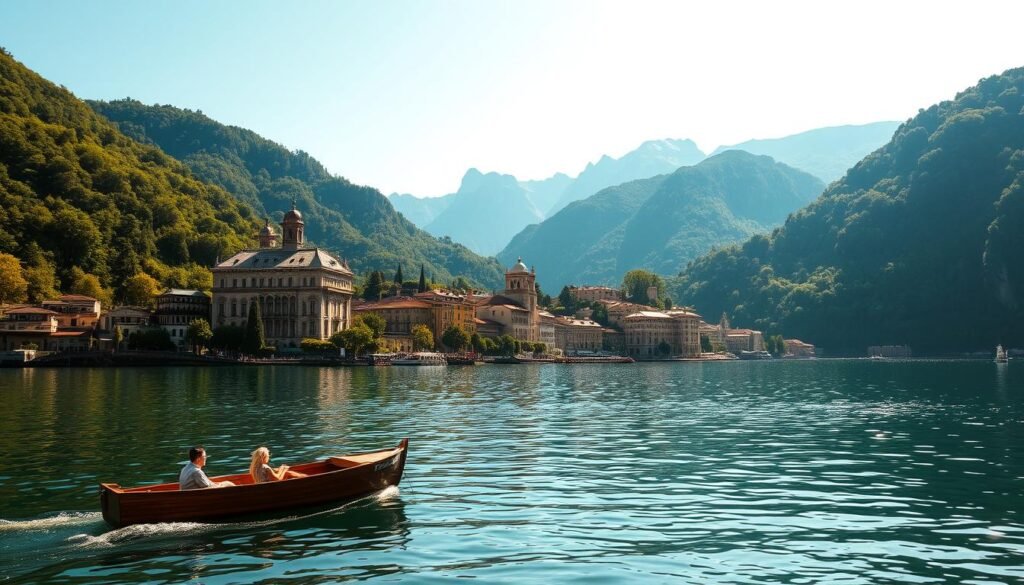
A short ferry ride and the lake opens like a painted postcard—steep hills, villas, and bright harbors. I base myself in either Varenna or Bellagio and let the ferries do the routing.
Bellagio, Varenna, Menaggio: classic lake-hopping loop
I use a simple triangle loop: Bellagio, Varenna, Menaggio. The ferries link these towns so a single day can cover all three without rushing.
My routine starts with coffee by the water, a slow promenade, then a short climb for higher views. Early mornings feel calm even in peak season; those hours are best for photos.
Villa Carlotta gardens and villa views I always make time for
I always visit Villa Carlotta for its art-filled rooms and terraced botanic gardens. The garden frames the lake from every angle and is a quiet place to linger.You can learn about best-time-to-visit-switzerland
“If I’m short on time, I still cross the water at least once—the ferry deck gives unbeatable views.”
- Base: Varenna or Bellagio for easy ferries.
- Timing: One full day for the three towns; a second day for a villa and relaxed meals.
- Tip: Pack light and favor early starts for tranquility.
| What | Why go | Suggested timing |
|---|---|---|
| Bellagio | Charming promenades and shops | Morning to midday |
| Varenna | Quieter harbor and climbable viewpoints | Late morning |
| Villa Carlotta | Gardens, art, and broad lake views | Afternoon |
Lake Garda: castles, thermal baths, and sunlit promenades
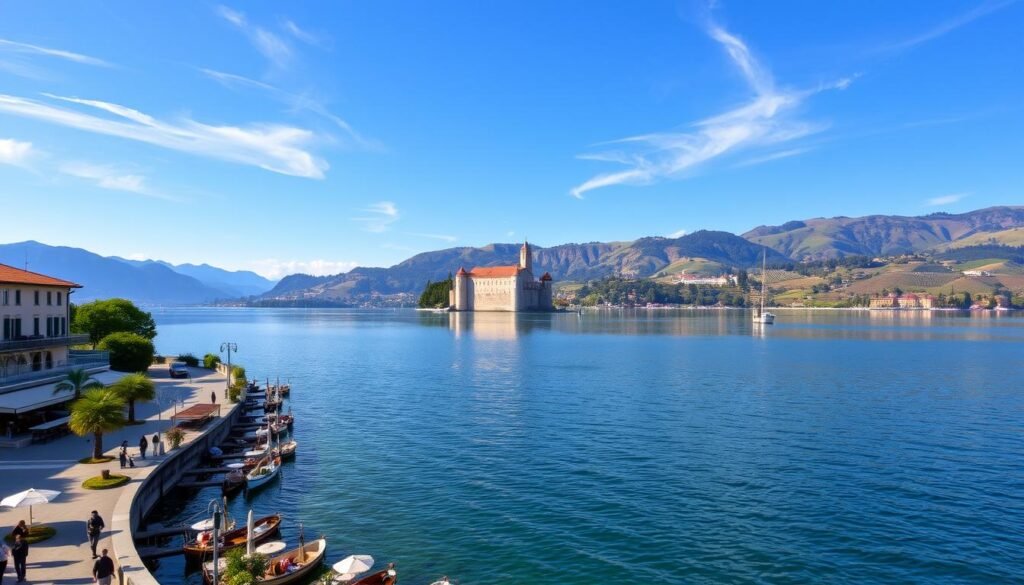
Lake Garda unfurls like a calm ribbon of water, where a moated fortress and warm spas sit within easy reach of quiet promenades. I head here when I want a mix of history and easy downtime.
Sirmione’s Scaliger Castle and lakeside spa downtime
I arrive at Sirmione early and walk the Scaliger Castle ramparts before the day-trippers appear. The castle is a striking site with medieval lanes that invite slow exploring.
Midday I book a soak at the thermal baths and let the warm water reset my pace. Later I stroll the promenades as the light softens and the water glows.
- Start early: explore ramparts and streets before crowds.
- Midday: schedule a thermal soak and a relaxed lunch.
- Getting around: use boats or buses to reach Riva del Garda or Malcesine for a full-lake feel without a car.
- Timing: one day gives a great taste; two days let you add another town and slow afternoons by the beaches or docks.
“Keep your swimsuit handy—quick dips from small beaches or hotel docks are often irresistible.”
The Dolomites: majestic peaks, alpine lakes, and a UNESCO World Heritage site
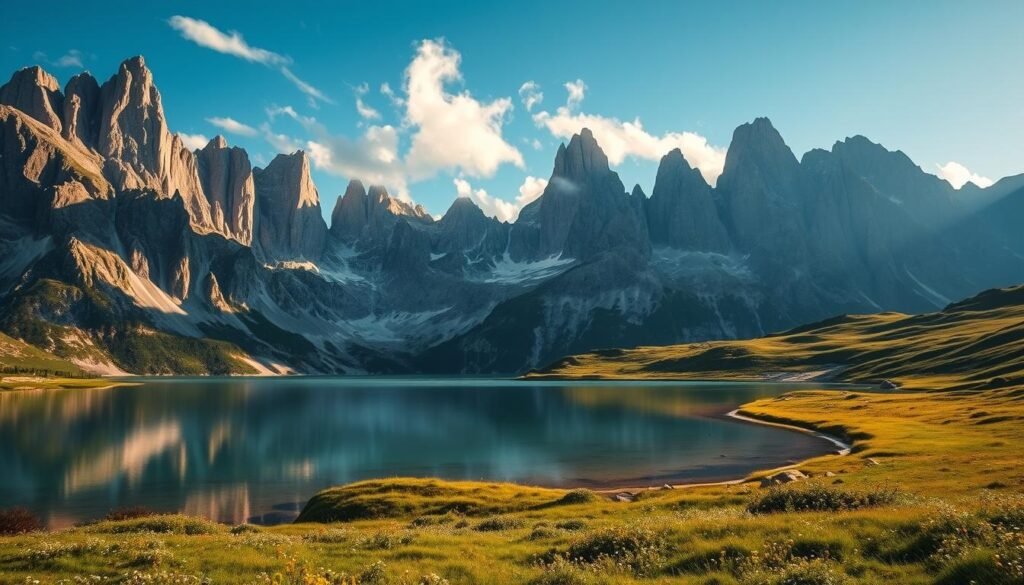
Jagged ridgelines and glassy lakes make this alpine region feel cinematic at every turn.
Tre Cime loop, Lago di Braies start, and Carezza’s emerald shore
I set one classic day for the Tre Cime di Lavaredo loop. The trail circles the jagged trio and offers nonstop views and easy rifugio stops.
At Lago di Braies I rise early for mirror reflections and quieter paths. Lago di Carezza is a quick, family-friendly circuit with otherworldly color.
- Balance big hikes with cable cars and drive-up passes so everyone sees the signature vistas.
- Base yourself in Toblach/Dobbiaco or Bolzano for a useful cultural mix and easier access.
- Two to three days gives me a weather buffer and time to pick highlights without rushing.
- I always pack layers; alpine sun can flip to a cold gust fast, even in summer.
“Small adjustments — an early start or a cable car — often turn a good day into a great one.”
| Site | Why I go | Access | When |
|---|---|---|---|
| Tre Cime di Lavaredo | Iconic ridges and loop hike | Trailhead by road; huts on route | Full day |
| Lago di Braies | Mirror reflections and calm mornings | Short walk around lake; parking nearby | Early morning |
| Lago di Carezza | Emerald water; short family circuit | Roadside access; short trail | Half day |
| Regional passes | Drive-up lookouts and cable cars | By car or public transfer | Flexible |
For a deeper primer on where the Dolomites sit, I also link a complete guide that helps plan routes and bases.
Tuscany Countryside: hill towns, wine roads, and cypress-lined dreams
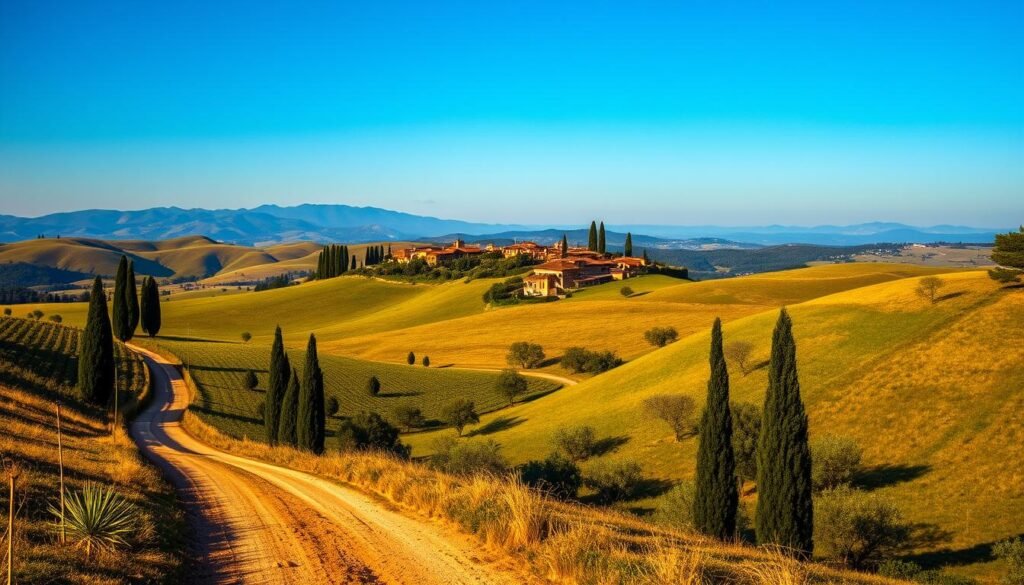
A short drive through low ridges reveals Renaissance facades, thermal pools, and lanes that seem made for golden-hour photos. I slow my pace here and let the landscape set my rhythm.
Val d’Orcia gems: Pienza, Montepulciano, and Monticchiello
I link small towns by car so I can stop for photos along cypress-lined lanes. I pair Pienza’s Renaissance architecture with Montepulciano’s wine tastings, then wind up at Monticchiello for expansive views and quiet village life.
Thermal bliss: Saturnia and Bagno Vignoni
Warm springs are a perfect mid-day pause. I plan a slow soak at Saturnia or Bagno Vignoni, then leave time to nap or read between dips. A long soak makes the countryside feel even softer.
Chianti day trips: vineyards, pici, and sunset drives
I dedicate a Chianti afternoon to farmhouse meals—pici with ragù—and a golden-hour drive across vineyard roads. I often stop at small wineries and farm stands I hadn’t planned for.
- Transport: I rent a car for flexibility across the region.
- Pacing: Two to three days let me cover a few villages each day and actually breathe the scenery.
- Tip: Leave space for unplanned finds—those are the best food and wine moments.
“Drive slowly; a lane you almost miss often leads to the best view.”
Bologna and Emilia-Romagna: porticoes, hearty cuisine, and lively piazzas
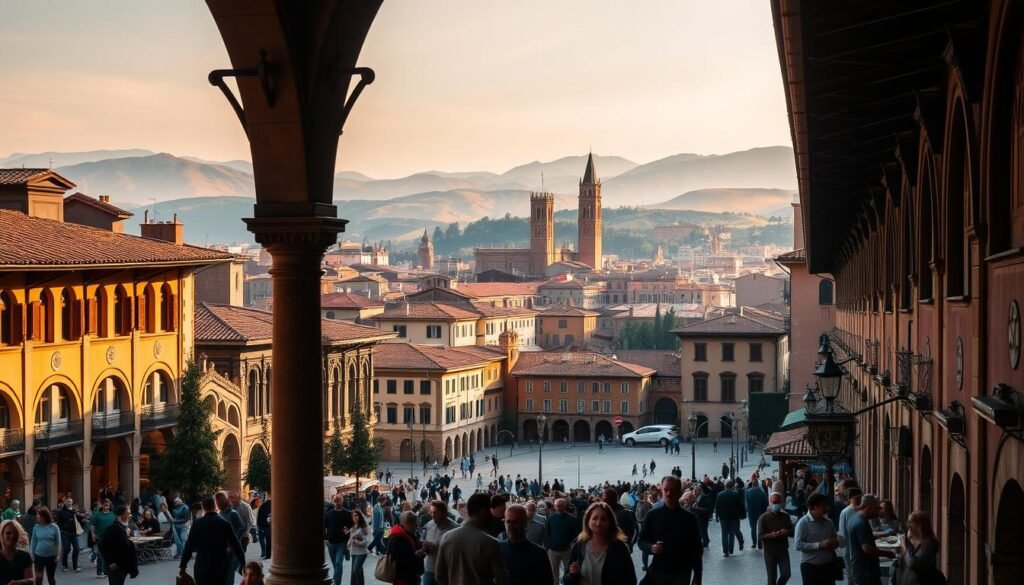
I love how Bologna greets me with a student hum, long porticoes, and the warm scent of slow-cooked ragù. The city mixes medieval towers with a lively culinary scene that rewards slow afternoons.
I start most visits at Piazza Maggiore, where the square anchors the old center. From there I climb the Asinelli Tower for roofline views before lunch. Climbing gives me a clear sense of the city layout and its many red-tiled roofs.
Piazza, tower, and a plate you remember
Lunch is often tagliatelle al ragù at a traditional trattoria. That one meal captures the region’s food heritage. Afterward I graze on cured meats and aged cheeses while wandering under the covered walkways.
I love to roam the porticoes and narrow streets. Bookstores, wine bars, and markets hide along atmospheric lanes. Museums and churches punctuate Bologna’s rich history, but the place truly lives in its cafes and osterie.
- I start at Piazza Maggiore, then climb Asinelli Tower.
- I make time for tagliatelle al ragù and local charcuterie.
- I duck into the Jewish Ghetto and venerable taverns like Osteria del Sole for offbeat local color.
- One full day covers the main landmarks and a couple of hearty meals without rushing.
| Highlight | Why I go | Suggested timing |
|---|---|---|
| Piazza Maggiore | Historic heart and outdoor life | Morning |
| Asinelli Tower | Panoramic roofline views | Late morning |
| Traditional Trattoria | Signature regional food | Lunch |
“Bologna’s charm is in its porticoes—walk, eat, and let the city’s easy rhythm set your pace.”
Umbria: Assisi’s sacred skyline and stone towns with timeless charm
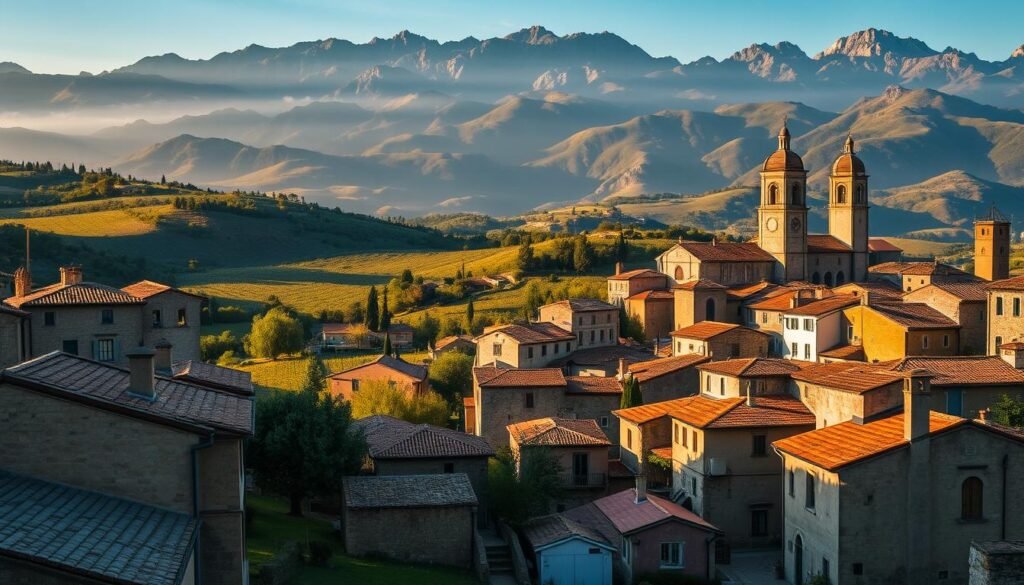
Umbria offers a hush of stone lanes and hilltop views where sacred sites and simple cafes sit within easy reach.
I balance Assisi’s pilgrimage draws—especially the Basilica of St. Francis and Santa Maria degli Angeli—with slow walks through shadowed lanes. The region’s church facades and quiet piazzas make the history feel immediate and personal.
Orvieto, Spello, Perugia: quiet beauty between Tuscany and Rome
I day trip to Orvieto for its dramatic hilltop cathedral and façade that wows up close. In Spello I chase flower-framed alleys and small wine bars for photos and easy evenings.
Perugia brings student energy and museums without the rush of a big city. I love Umbria for low-key villages and uncrowded views that pair well with day trips from Rome or Tuscany.
“Two days here gives time for churches, panoramas, and lingering lunches.”
- I balance pilgrimage sites with cafe breaks so the past feels lived-in.
- Orvieto is a dramatic day trip; Spello is for slow pictures and wine.
- Perugia adds lively nights and museum variety without crowds.
| Site | Why I go | Suggested timing |
|---|---|---|
| Assisi (Basilica) | Franciscan art and serene skyline | Morning + afternoon |
| Orvieto | Hilltop cathedral and dramatic views | Day trip |
| Spello / Perugia | Flowered lanes; student life and museums | Late afternoon to evening |
Sorrento and the Amalfi Coast: glamorous drives, lemon groves, and sea views
I often choose Sorrento as my base because it makes exploring the southern cliffs simple and scenic. From there I hop by ferry or car along the amalfi coast, pausing for terraces and seaside cafés.
Positano, Amalfi, and Ravello’s Villa Rufolo terraces
Positano’s steep lanes and Amalfi’s cathedral feel lived-in yet cinematic. I time Ravello’s Villa Rufolo for late afternoon when the gardens glow and the views stretch for miles.
Best day trips: Capri by boat and ancient Pompeii
I reserve a full day for Capri by boat and another half or full day for Pompeii’s haunting streets. Ferries save nerves and offer open-air sea time that beats narrow mountain roads.
- I base in Sorrento, then day trip along the coastline to Positano, Amalfi, and Ravello.
- I pick one beach stop—tiny coves make the best quick swims.
- Two or three days let me mix cliffside towns and terrace views without rushing.
“Ride the ferry when you can — the route becomes part of the memory.”
| Stop | Why go | Timing |
|---|---|---|
| Positano | Photogenic lanes and waterfront cafés | Morning to midday |
| Amalfi | Historic center and cathedral | Afternoon |
| Ravello / Villa Rufolo | Terraced gardens and long views | Late afternoon |
Capri: Blue Grotto light, cliffside trails, and elegant gardens
Capri feels like a miniature island of contrasts—chic shopping lanes above and wild cliff trails below.
I usually start with the open-air chairlift up Mount Solaro. The ride gives instant views and a sense of the island’s rugged side.
From the summit I walk down quiet paths toward the Gardens of Augustus. That terrace frames the Faraglioni sea stacks and makes for classic photos.
Mount Solaro by chairlift and the Gardens of Augustus
I pick one small cove or a beach club for a long lunch and a swim. A single relaxed day covers the chairlift, gardens, and a seaside pause.
If the waters are calm and the lines look reasonable, I add the Blue Grotto for its electric-blue glow. Otherwise, I save that for an early morning boat run.
- I weave Roman ruins like Villa Jovis into short walks so history and modern villas feel linked.
- An overnight stay is useful: mornings and evenings are quieter after day-trippers leave.
- The island’s compact town life, rocky paths, and coastal beauty balance well across two restful days if you have time.
“A chairlift up, a garden down, and a quiet cove for an afternoon—Capri rewards slow moving.”
Puglia: whitewashed towns, trulli heritage, and sun-drenched beaches
Walking Puglia feels like stepping through a living postcard of whitewashed towns and olive groves. I split my time between inland lanes and the coast so I can soak up trulli roofs, ornate Baroque facades, and clear turquoise water.
Alberobello’s trulli, Lecce’s Baroque glow, and Polignano a Mare
I wander Alberobello early, when the cone-shaped trulli look almost private and quiet. Then I head to Lecce for its creamy stone architecture and an aperitivo hour that lasts until sunset.
Polignano a Mare gives me cliffside views and sea caves. I plan a swim between strolls and hunt for seafood at the market for my main meal.
“Two to three days lets you savor towns and shore without long drives.”
- I focus meals on orecchiette, olive oil tastings, and fresh seafood.
- I mix inland whitewashed lanes with sandy beaches and rocky coves each day.
- For more on regional towns, see my short guide to towns in Puglia.
| Spot | Why I go | Best time | Tip |
|---|---|---|---|
| Alberobello | UNESCO trulli and narrow lanes | Early morning | Wear comfy shoes for stones |
| Lecce | Ornate Baroque churches and cafés | Late afternoon | Stay for aperitivo |
| Polignano a Mare | Cliffs, sea caves, and swims | Midday to late afternoon | Try seafood from the market |
Matera: haunting beauty in the Sassi and a unique UNESCO world heritage site
Walking Matera feels like stepping into a living chronicle of rock-cut houses and quiet, echoing alleys. The Sassi districts are ancient cave neighborhoods carved into limestone and now restored with boutique cave hotels and museums.
Churches in the rock and cave-stay magic
I arrive early and explore the stone streets before tours fill the tiny alleys and stairways. The light makes every carved doorway and stair feel cinematic, a real draw for film crews — yes, even a 007 scene was shot here.
I visit a casa grotta museum to learn how people lived in cave houses for centuries. I step into rock churches and find frescoes and quiet traces of daily worship carved into the walls.
- I stay one night in a cave hotel — quiet nights feel suspended in time.
- I plan for uneven steps; sturdy shoes make wandering effortless and safe.
- One full day reveals layers of history and ruins; an overnight deepens the memory of this city site on the UNESCO list.
Sicily Highlights: Palermo’s markets, Taormina’s views, and the Valley of the Temples
This island feels like a patchwork of cultures—Norman palaces, Greek ruins, and fishing harbors sit close enough for easy day plans.
Palermo’s Arab-Norman landmarks and street-food energy
I dive into Palermo’s markets first, tasting street food and soaking up the local culture before touring the cathedral and the Norman Palace with its Cappella Palatina.
Monreale is a short bus ride for mosaics that gleam like trapped sunlight; those golden panels feel like a living fragment of Sicily’s layered history.
Siracusa, Monreale, and the Valley
Siracusa pairs a grand Duomo with a Greek theater where the light turns the stage and the sea into a backdrop.
I reserve a half day for the Valley of the Temples in Agrigento; the Temple of Concordia stands remarkably intact among the ancient ruins.
“String these towns over several days or pick one as an anchor for a shorter sampler.”
| Site | Why I go | Timing |
|---|---|---|
| Palermo Markets & Palaces | Food, Arab-Norman art, lively streets | Morning then afternoon |
| Monreale | Gold-glass mosaics and quiet views | Midday |
| Valley of the Temples (Agrigento) | Greek temples, valley temples, dramatic ruins | Half day |
| Taormina | Greek theater with Etna and coastline views | Late light |
Conclusion
Standing back, I see a country you can thread like a necklace—city jewels, lake pearls, and coastal charms.
I highlight UNESCO world heritage spots such as the Cinque Terre coastline, Matera’s Sassi, and the Valley of the Temples so the story of ancient life stays with you. These heritage sites sit alongside world-class museums and lively streets that reward both one-day stops and longer stays.
I balance museum days in a city with slow afternoons in small towns and by lakes like Como and Garda. The Amalfi Coast and Cinque Terre act as bookends: cliffside villages, sea air, coastline walks, and quiet moments that feel like home.
This list is a roadmap, not a rulebook: pick a region, a lake, a coast, and a town, leave room for serendipity, and let the highlights become your own lasting memories.


